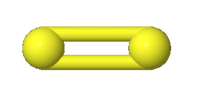- Disulfur
-
Disulfur  DisulfurOther namesDiatomic sulfur
DisulfurOther namesDiatomic sulfur
Sulfur
Sulfur dimerIdentifiers CAS number 23550-45-0 
PubChem 5460602 ChemSpider 4574100 
ChEBI CHEBI:29387 
Gmelin Reference 753 Jmol-3D images Image 1 - [S][S]
Properties Molecular formula S2 Molar mass 64.13 g mol−1 Exact mass 63.944141380 g mol-1 Dipole moment 0 D Thermochemistry Std enthalpy of
formation ΔfHo298128.60 kJ mol-1 Standard molar
entropy So298228.17 kJ K-1 mol-1 Specific heat capacity, C 32.51 kJ K-1 mol-1 Related compounds Related compounds Triplet oxygen  (verify) (what is:
(verify) (what is:  /
/ ?)
?)
Except where noted otherwise, data are given for materials in their standard state (at 25 °C, 100 kPa)Infobox references Disulfur is the diatomic molecule with the formula S2.[1] It is analogous to the dioxygen molecule but rarely occurs at room temperature. This violet gas is commonly generated by heating sulfur above 720 °C and comprises 99% of vapor species at low pressure (1 mm Hg) at 530 °C. S2 is one of minor components of the atmosphere of Io’s, which is dominantly composed of SO2.[2] Diatomic molecules are common containing C, O, N and F, but for heavier elements they are often only stable at high temperatures.
Production
Disulfur results when an atmosphere of COS is irradiated with UV light using a mercury photosensitizer or when CS2, H2S2, S2Cl2 or C2H4S are photolyzed. Singlet S2 is also formed when sulfur compounds such as H2S, PSF3 or COS are photolyzed. S2 can be generated by heating various organosulfur precursors.[3]
Properties
S2 exists in the triplet state like O2, i.e. both are diradicals. It has S-S double bond length of 189 pm, much shorter than the S-S single bonds in S8, which are 206 pm. In its Raman spectrum, the S-S vibrational band is observed at 715 cm−1.[4] The corresponding vibrational band of O-O is found at 1122 cm−1. The S-S bond energy is 265 kJ/mol compared to 498 kJ/mol for O2.
Sulfur has a large number of allotropes, perhaps as many as thirty. Their specific properties are distinguishable by various types of spectroscopy. The only stable form of sulfur at normal condition is S8.[5]
References
- ^ B. Eckert. R. Steudel “Solid Sulfur Allotropes”, Topic in Current Chemistry (2003) volume 231, pages 1-79. doi:10. 1007/b12110B.
- ^ Emmanuel Lellouch "Io’S Atmosphere and Surface-Atmosphere Interactions", LESIA, Observatoire de Paris, F-92195 Meudon. doi:10.1 007/s11214-005-1957-z
- ^ Sylvie L. Tardif, Andrzej Z. Rys, Charles B. Abrams, Imad A. Abu-Yousef, Pierre B. F. Leste-Lasserre, Erwin K. V. Schultz, and David N. Harpp “Recent Chemistry of the Chalcogen Diatomics” Terrahedron, Vol. 53, No 36, pp. 12225-12236. doi:10.1016/S0040-4020(97)00555-3
- ^ B. Eckert, Ralf Steudel “Molecular Spectra of Sulfur Molecules and Solid Sulfur Allotropes”, Topics in Current Chemistry (2003) volume 231, pages 31–98. doi:10.1007/b13181
- ^ A. F. Holleman, N. Wiberg. Inorganic Chemistry. Academic Press; Berlin ; New York : De Gruyter, 2001.ISBN 0-12-352651-5.
Wikimedia Foundation. 2010.
